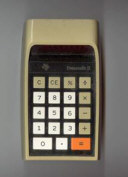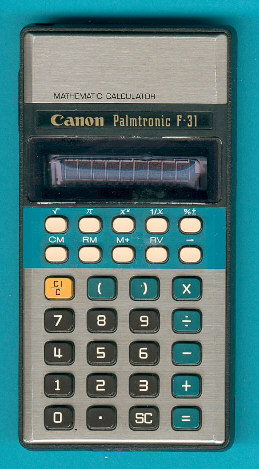
DATAMATH CALCULATOR MUSEUM
 |
DATAMATH CALCULATOR MUSEUM |
Canon Palmtronic F-31
| Date of introduction: | year 1977 | Display technology: | Fluorescent |
| New price: | Display size: | 8 | |
| Size: | 5.7" x 3.0" x
0.8" 145 x 76 x 21 mm3 |
||
| Weight: | 4.3 ounces, 121 grams | Serial No: | 644435 |
| Batteries: | 2*AA | Date of manufacture: | mth 06 year 1977 |
| AC-Adapter: | Origin of manufacture: | Japan | |
| Precision: | 8 | Integrated circuits: | TMS1045 (KSΔ7723) |
| Memories: | 1 | Displays: | Futaba 9-ST-11 |
| Program steps: | Courtesy of: | Joerg Woerner |

![]()
 This
Canon Palmtronic F-31 was introduced in 1977 and based on the leading "F" in its
product name, we would consider it as a Scientific Calculator. Here at the
Datamath Calculator Museum we expect a scientific calculator to include the
following capabilities:
This
Canon Palmtronic F-31 was introduced in 1977 and based on the leading "F" in its
product name, we would consider it as a Scientific Calculator. Here at the
Datamath Calculator Museum we expect a scientific calculator to include the
following capabilities:
| • Scientific notation • Floating-point decimal arithmetic • Logarithmic functions, using both base 10 and base e • Trigonometric functions • Exponential functions and roots beyond the square root • Constants such as pi and e |
Well, the F-31 checks only a few of the boxes and Canon consequently marketed it as "Mathematic Calculator" and it defined the lower end of an impressive portfolio of 5 products in 1977:
| Model | Introduction | Functions | Calculator IC |
| F-31 | 1977 | Enhanced-Basic | Texas Instruments TMS1045 |
| F-41 | 1976 | Basic-Scientific | Matsushita MN9002 |
| F-51 | 1977 | Full-Scientific | NEC uPD951C |
| F-61 | 1977 | Scientific-Statistic | NEC uPD955C |
| F-71 | 1977 | Scientific-Statistic | Hitachi HD36140, HD36141 |

 Dismantling the featured F-31 calculator manufactured in June 1977
in Japan reveals a very cost effective design using a single-sided printed circuit board
(PCB) centered around a TMS1045 single-chip calculator circuit connected to a 9-digit
Vacuum Fluorescent Display (VFD), a keyboard assembly and powered by 2 AA-sized
alkaline batteries.
Dismantling the featured F-31 calculator manufactured in June 1977
in Japan reveals a very cost effective design using a single-sided printed circuit board
(PCB) centered around a TMS1045 single-chip calculator circuit connected to a 9-digit
Vacuum Fluorescent Display (VFD), a keyboard assembly and powered by 2 AA-sized
alkaline batteries.
![]()
 The
TMS1045 is a member of the TMS1040 Product Family based on the
TMS1070
"computer-on-a-chip" introduced in 1974 with the original
TMS1000.
While the TMS1070 can directly interface with low-voltage VFD up to 35 Volts
does it still need external resistors and a zener diode to bias the anodes and
grids of the display with respect to the filament. The TMS1040 added an extra
VPP pin to connect a negative 30 Volts bias voltage for its modified
output drivers. With the TMS1070 featuring 11 R Outputs for the Digits, 8 O
Outputs for the Segments and 4 K Inputs for the Keyboard, reduced the TMS1040
the number of R Outputs to 9, consequently are all known TMS1040 calculator
designs using a 9-digit VF Display.
The
TMS1045 is a member of the TMS1040 Product Family based on the
TMS1070
"computer-on-a-chip" introduced in 1974 with the original
TMS1000.
While the TMS1070 can directly interface with low-voltage VFD up to 35 Volts
does it still need external resistors and a zener diode to bias the anodes and
grids of the display with respect to the filament. The TMS1040 added an extra
VPP pin to connect a negative 30 Volts bias voltage for its modified
output drivers. With the TMS1070 featuring 11 R Outputs for the Digits, 8 O
Outputs for the Segments and 4 K Inputs for the Keyboard, reduced the TMS1040
the number of R Outputs to 9, consequently are all known TMS1040 calculator
designs using a 9-digit VF Display.

 Looking
closer onto the PCB you'll notice four diodes labeled D1 and placed
somehow between the TMS1045 and the keyboard assembly - at first glance an unusual
approach. Preparing our DCM-50A Platform
to allow the Characterization of Single-Chip Calculator Circuits
of the TMS1040 Family, we reverse-engineered the F-31 calculator and
understood that Texas Instruments started to add with the TMS1040 a "virtual"
5th Keyboard Input line by using two additional diodes emulating the 5 K Inputs
of the TMC0980 Family. While the
TMS0100 single-chip calculator circuit
introduced the concept of an 11x4 keyboard matrix scanned with the 11 Digit
Outputs and 4 Keyboard Inputs, would the reduction to just 9 Digit Outputs of
the TMS1040 allow for only 9x4 keys and switches, in some calculator
applications like this F-31 a show-stopper. Adding an extra "virtual" Keyboard
Input allows consequently for a 9x5 keyboard matrix and this F-31 arranges its
30 keys within a 9x4 grid and uses one Keyboard Input for both the 4-position [+
2 0 F] sliding switch and a "Diode Jumper" as an "Always-on" switch to select
certain software features embedded in the TMS1045 firmware.
Looking
closer onto the PCB you'll notice four diodes labeled D1 and placed
somehow between the TMS1045 and the keyboard assembly - at first glance an unusual
approach. Preparing our DCM-50A Platform
to allow the Characterization of Single-Chip Calculator Circuits
of the TMS1040 Family, we reverse-engineered the F-31 calculator and
understood that Texas Instruments started to add with the TMS1040 a "virtual"
5th Keyboard Input line by using two additional diodes emulating the 5 K Inputs
of the TMC0980 Family. While the
TMS0100 single-chip calculator circuit
introduced the concept of an 11x4 keyboard matrix scanned with the 11 Digit
Outputs and 4 Keyboard Inputs, would the reduction to just 9 Digit Outputs of
the TMS1040 allow for only 9x4 keys and switches, in some calculator
applications like this F-31 a show-stopper. Adding an extra "virtual" Keyboard
Input allows consequently for a 9x5 keyboard matrix and this F-31 arranges its
30 keys within a 9x4 grid and uses one Keyboard Input for both the 4-position [+
2 0 F] sliding switch and a "Diode Jumper" as an "Always-on" switch to select
certain software features embedded in the TMS1045 firmware.
The Unisonic Model 1040-1 calculator using with the TMS1044 another product of the TMS1040 portfolio sports only 27 keys and an hard-wired power [on/off] switch but nevertheless makes use of the "virtual" 5th Keyboard Input line. And don't miss the Brinlock Model 806 for the true champion in the TMS1040 league.
Don't miss the Canola L813, Toshiba BC-8111B and BC-8112SL using the TMS1045 without looking like a scientific calculator and the BC-8018B bringing down the number of keys to just 20.
The housing of the F-31 was used with the third series of the Palmtronic LD-10M, too.
If you have additions to the above article please email: joerg@datamath.org.
© Joerg Woerner, December 5, 2001. No reprints without written permission.